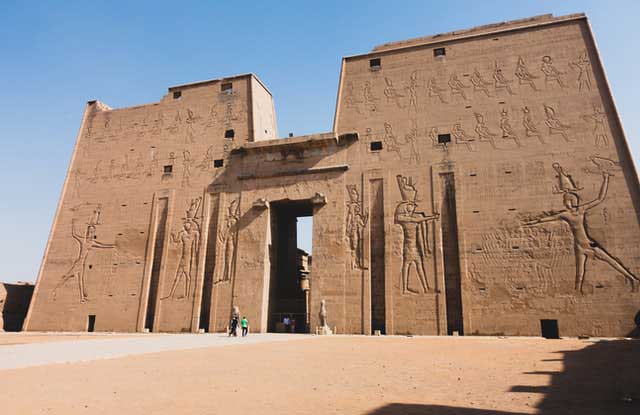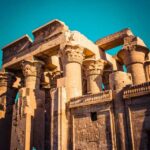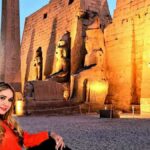The Temple of Horus at Edfu is considered to be the most well preserved temple in Egypt, Preserved by desert sand, which filled the place after the pagan cult was banned. It is the perfect example of the ancient egyptian temples. Visiting it gives you acomplete vision about how the other temples should look like. It was built during the Greco-Roman Period, but the builders painstakingly preserved the form of Egypt’s true pharaohs. The temple is dedicated to Horus, the avenging son of Isis and Osiris. With its roof intact, it is also one of the most atmospheric of ancient buildings.
The Temple of Horus at Edfu is widely considered to be the most impressive of all of the Nile-side temples along the journey between Luxor and Aswan. It is a required stop by all of the cruise ships that make the trip, also stopping at Esna and Kom Ombo.
This article contains information about visiting Temple of Edfu including:
- Where is Edfu Temple Located?
- What is the best way for visiting Edfu Temple?
- How much does it cost to visit the Temple of Edfu?
- Who built Edfu Temple and when?
- What is the religious significance of Edfu Temple?
- The layout and design of Edfu Temple
- What happened to Edfu Temple?
- Recommended Travel holiday packages to Egypt including Edfu Temple
Where is Edfu Temple located?
The temple of Horus is located at the center of a town called Edfu, exactly located by the middle of Aswan and Luxor towns. Edfu was a settlement and cemetery site from around 3000 BC onward. It was the ‘home’ and cult centre of the falcon god Horus of Behdet (the ancient name for Edfu), although the Temple of Horus as it exists today is Ptolemaic.
What is the best way for visiting Edfu Temple?
If you’re planning a day trip, we recommend combining your visit with a tour of the Temple of Kom Ombo, which is located a little over an hour north of Aswan, and around an hour and a half south of Edfu. You’ll enjoy the ease and comfort of transfers in an air-conditioned vehicle, all entrance fees included, and an English-speaking guide to explain the fascinating stories surrounding the ancient monuments:
- Edfu & Kom Ombo Day Trip from Luxor
- Edfu & Kom Ombo Day Trip from Aswan
Alternatively, visit the Temple of Horus at Edfu as part of a cruise up the Nile River, stopping at all of the most iconic sights between Aswan and Luxor. Get picked up from your hotel, the airport or train station, and enjoy a luxury cruise to visit the Temple of Isis at Philae, the Kom Ombo Temple, the Temples of Luxor and Karnak, Hatshepsut Temple, the Colossi of Menmon and the Valleys of the Kings and Queens.

How much does it cost to visit the Temple of Horus at Edfu?
Tickets, which cost 180 Egyptian pounds (approximately $12) for adults and 90 Egyptian pounds (or $6) for students, can be purchased at the entrance’s gate.
Who built Edfu Temple and when?
The building was started during the reign of Ptolemy III Euergetes and completed in 57 BC under Ptolemy XII Auletes. It was built on the site of an earlier, smaller temple also dedicated to Horus, although the previous structure was oriented east-west rather than north-south as in the present site. A ruined pylon lies just to the east of the current temple; inscriptional evidence has been found indicating a building program under the New Kingdom rulers Ramesses I, Seti I and Ramesses II.
A naos of Nectanebo II, a relic from an earlier building, is preserved in the inner sanctuary, which stands alone while the temple’s barque sanctuary is surrounded by nine chapels.
Started by Ptolemy III (246–221 BC) on 23 August 237 BC, on the site of an earlier and smaller New Kingdom structure, the sandstone temple was completed some 180 years later by Ptolemy XII Neos Dionysos, Cleopatra VII’s father. In conception and design it follows the general plan, scale, ornamentation and traditions of Pharaonic architecture, right down to the Egyptian attire worn by Greek pharaohs depicted in the temple’s reliefs. Although it is much newer than cult temples at Luxor or Abydos, its excellent state of preservation helps to fill in many historical gaps; it is, in effect, a 2000-year-old example of an architectural style that was already archaic during Ptolemaic times.
What is the religious significance of Edfu Temple?
The temple of Edfu is the largest temple dedicated to Horus and Hathor of Dendera. It was the center of several festivals sacred to Horus. Each year, “Hathor travelled south from her temple at Dendara to visit Horus at Edfu, and this event marking their sacred marriage was the occasion of a great festival and pilgrimage.
The design and layout of Edfu Temple
Edfu was one of several temples built during the Ptolemaic Kingdom, including the Dendera Temple complex, Esna, the Temple of Kom Ombo, and Philae. Its size reflects the relative prosperity of the time. The present temple, which was begun “on 23 August 237 BC, initially consisted of a pillared hall, two transverse halls, and a barque sanctuary surrounded by chapels.
Beyond the Roman mammisi (birth house), with some colourful carvings, the massive 36m-high pylon (gateway) is guarded by two huge but splendid granite statues of Horus as a falcon. The walls are decorated with colossal reliefs of Ptolemy XII Neos Dionysos, who is holding his enemies by their hair before Horus and is about to smash their skulls; this is the classic propaganda pose of the almighty pharaoh.
Beyond this pylon, the court of offerings is surrounded on three sides by 32 columns, each with different floral capitals. The walls are decorated with reliefs, including the ‘Feast of the Beautiful Meeting’ just inside the entrance, the meeting being that of Horus of Edfu and Hathor of Dendara, who visited each other’s temples each year and, after two weeks of great fertility celebrations, were magically united.
A second set of Horus falcon statues in black granite once flanked the entrance to the temple’s first or outer hypostyle hall, but today only one remains. Inside the entrance of the outer hypostyle hall, to the left and right, are two small chambers: the one on the right was the temple library where the ritual texts were stored; the chamber on the left was the hall of consecrations, a vestry where freshly laundered robes and ritual vases were kept. The hall itself has 12 columns, and the walls are decorated with reliefs of the temple’s founding.
The inner hypostyle hall also has 12 columns, and in the top left part of the hall is perhaps this temple’s most interesting room: the temple laboratory. Here, all the necessary perfumes and incense recipes were carefully brewed and stored, their ingredients listed on the walls.
Exit the inner hypostyle hall through the large central doorway to enter the offering chamber, or first antechamber, which has an altar where daily offerings of fruit, flowers, wine, milk and other foods were left. On the west side, 242 steps lead up to the rooftop and its fantastic view of the Nile and the surrounding fields. (The roof is closed to visitors.)
The second antechamber gives access to the sanctuary of Horus, which contains the polished-granite shrine that once housed the gold cult statue of Horus. Created during the reign of Nectanebo II (360–343 BC), this shrine, or house of the god, was reused by the Ptolemies in their newer temple. In front of it stands a replica of the wooden barque (boat) in which Horus’ statue would be taken out of the temple in procession during festive occasions: the original is now in the Louvre, Paris.
On the eastern enclosure wall, look for the remains of the Nilometer, which measured the level of the river and helped predict the coming harvest.
What happened to Edfu Temple?
The temple of Edfu fell into disuse as a religious monument following Theodosius I’s persecution of pagans and edict banning non-Christian worship within the Roman Empire in 391. As elsewhere, many of the temple’s carved reliefs were razed by followers of the Christian faith which came to dominate Egypt. The blackened ceiling of the hypostyle hall, visible today, is believed to be the result of arson intended to destroy religious imagery that was then considered pagan.
Over the centuries, the temple became buried to a depth of 12 metres (39 ft) beneath drifting desert sand and layers of river silt deposited by the Nile. Local inhabitants built homes directly over the former temple grounds. Only the upper reaches of the temple pylons were visible by 1798, when the temple was identified by a French expedition. In 1860 Auguste Mariette, a French Egyptologist, began the work of freeing Edfu temple from the sands.
The Temple of Edfu is nearly intact and a very good example of an ancient Egyptian temple. The Its archaeological significance and high state of preservation has made it a centre for tourism in Egypt and a frequent stop for the many riverboats that cruise the Nile. In 2005, access to the temple was revamped with the addition of a visitor center and paved carpark. A sophisticated lighting system was added in late 2006 to allow night visits










